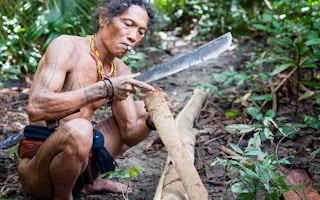Climate finance, while efficient in sectors such as renewable energy, is not effective in protecting increasingly threatened forests or the rights of their inhabitants, a new report shows.
“It’s just so much easier to put money into wind farms,” Charlotte Streck, director of the advisory company Climate Focus, says during the launch of the report (24 October) in London attended by a delegation of indigenous leaders from Brazil, Indonesia and other developing countries. “You have energy projects worth hundreds of million dollars that are easy to invest in, easy to assess and whose results are measurable.”
To emphasise the neglect, the report compared the finance flowing towards forest protection and subsidies supporting intensive agriculture and land development.
Findings show that the US$20 billion invested in stopping deforestation is dwarfed by the almost US$780 billion spent since 2010 in what the authors call ‘grey finance’—which has an unclear but potentially negative impact on forests.
These include investments in key deforestation drivers such as beef production, timber and palm oil. “We need more and also better climate finance,” says Franziska Haupt, a senior land use consultant with Climate Focus.
“
While many governments and companies often spend a lot of money in forest protection, the most effective and the cheapest solution lies in the hands of the people who live in the forest.
Mina Setra, deputy secretary-general, Indigenous Peoples Alliance of the Archipelago
“This means being more strategic, targeting deforestation and looking at opportunities to introduce safeguards.”
Haupt cites banks like the HSBC, which now terminates contracts with customers who do not meet sustainability standards, and the Dutch bank ASN, which avoids investing in palm oil, soy and beef companies, as examples of businesses which have introduced safeguards and requirements for their clients to avoid negatively impacting the forest.
However, she emphasises that while protection policies and green investments are desirable, transformative change depends on people who live on the ground and can help implement any new measure. “You need money but also political will and institutions that can bring local communities together and raise their voices.”
Environmental campaigners say that protecting the rights of indigenous people is the cheapest and most effective way of keeping the forests healthy as supported by mounting scientific evidence.
A study published last year showed how the life and rights of indigenous people are deeply intertwined with the health of their land. It found that indigenous people manage more than 24 per cent of the carbon trapped by the world’s tropical forests, equivalent to 250 times the amount of CO2 produced by global air travel in 2015.
Mina Setra, deputy secretary-general of the Indigenous Peoples Alliance of the Archipelago, tells SciDev.Net: “It is very important that land tenure and indigenous rights are recognised, because while many governments and companies often spend a lot of money in forest protection, the most effective and the cheapest solution lies in the hands of the people who live in the forest.”
She says that as a first step to assert their rights, indigenous people in Indonesia have been mapping their territories for a few decades, tracking boundaries as well as information on livelihoods and local culture. Their goal is to demonstrate that they do not just occupy a given area but they have been living there for a long time, establishing a wide range of customs and informal institutions.
Forest protection, Setra says, “is not just about the trees, it’s about a system that is not working”. For example, palm oil plantation and mining are longstanding issues in Indonesia, but “as long as the demand from Europe and other rich regions remains high, the industry will keep growing”, she adds.
This piece was produced by SciDev.Net’s Asia & Pacific desk.










